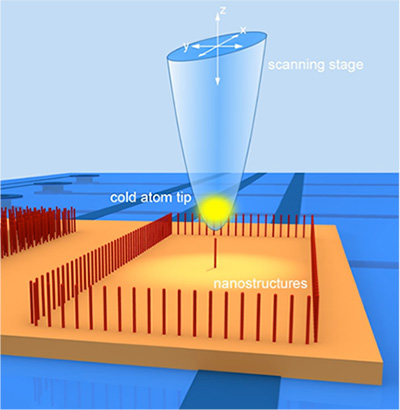| 概 要 |
Trapping and manipulating atoms by means of microscopic traps has seen enormous advances within the last decade. Today, ultra-cold atom clouds, Bose-Einstein condensates, and Fermi gases are routinely trapped in conservative potential at the surface of microchips [1]. Such experiments have delivered important insights into fundamental interactions between atoms and surfaces and pave the way towards the coherent coupling between atoms and quantum electronic circuits.
In our experiments, we investigate the quantum interface between atomic clouds and superconducting devices. In general, the state of a superconducting quantum bit can be manipulated at microelectronic rates. However, its decoherence is fast due to the coupling to the thermal environment. Transferring the quantum state to cold atoms as quantum memory may bridge sort and long time scales. At the same time, the state of atoms can be mapped to photonic quantum states and it can be transferred to distant systems. We develop experimental techniques towards the realization of such solid state-atomic-light quantum interface. I report the realization of a trapped rubidium atomic clock on a superconducting chip. We use the atomic clock to demonstrate the long coherence time of atomic superposition states near the superconductor, which is necessary for constructing a long living quantum memory.
Another subject of our research is the development of integrated quantum sensors based on ultra-cold atoms. I describe the application of ultra-cold atom clouds as the “tip” of a scanning probe microscope [2]. This tip (typically 103–105 atoms, density 1012–1014 cm-3, temperature 10nK–1μK) is scanned in a three-dimensional volume above the surface of interest by means of a magnetic “conveyor belt”. Analog to AFMs, the cold-atom scanning probe microscope (CA-SPM) can be operated in contact and dynamical modes for imaging surface topographies and for ultrasensitive force measurements. While AFMs have much sharper tips and reach about four orders of magnitude higher spatial resolution, cold atom tips have up to fifteen orders of magnitude smaller spring constants and reach extremely high force sensitivities in the sub-yN (<10-24N) range. I report the non-destructively measurement of the position and height of free standing carbon nanotubes and the measurement of dispersion forces between atoms and nanotubes [3].
References
1. J. Fortágh, C. Zimmermann, “Magnetic microtraps for ultracold atoms”,
Reviews of Modern Physics 79, 235 (2007).
2. M. Gierling et al., “Cold-atom scanning probe microscopy”,
Nature Nanotechnology 6, 446-451 (2011).
3. P. Schneeweiß et al., “Dispersion forces between ultracold atoms and a carbon nanotube”,
Nature Nanotechnology 7, 515-519 (2012)

|